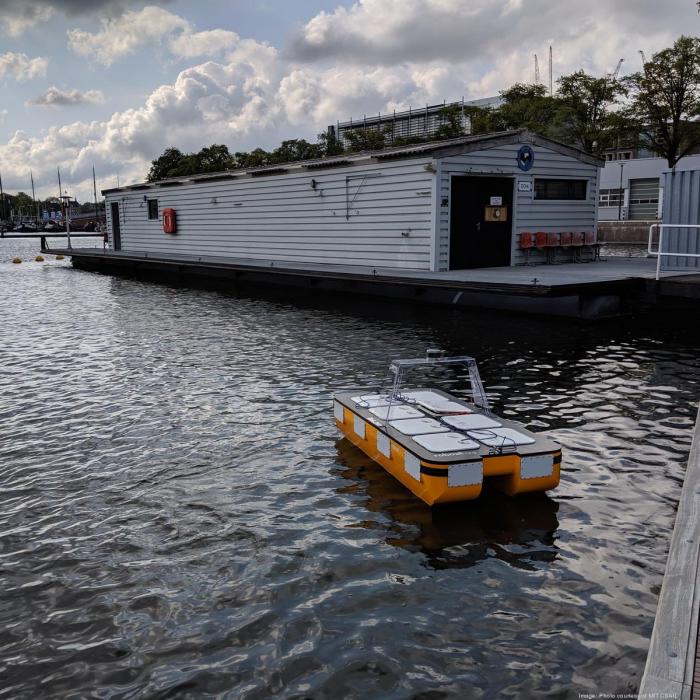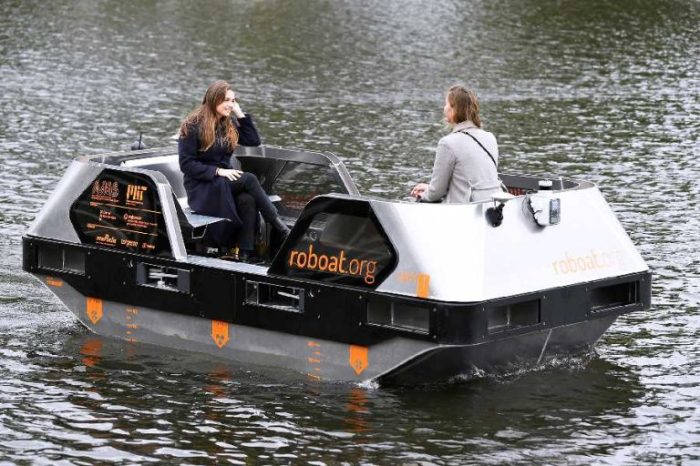Self-Driving Boats
Forget self-driving cars, Amsterdam will soon test self-driving boats. The Dutch capital is leading the charge in the world of autonomous navigation, with plans to launch a fleet of self-driving boats that will navigate the city’s canals. This innovative move marks a significant step towards the future of transportation, and it highlights the potential of self-driving technology beyond the realm of automobiles.
Technology and Innovation
Self-driving boats are powered by a complex interplay of technology and innovation, relying on advanced systems to navigate, sense, and make decisions autonomously. The key technologies driving these boats include:
* Navigation Systems: These systems are responsible for planning routes, calculating optimal paths, and maintaining the boat’s position. Advanced algorithms, coupled with real-time data from sensors, allow the boats to navigate complex waterways, avoiding obstacles and adhering to traffic regulations.
* Sensors: Self-driving boats are equipped with a suite of sensors that provide crucial information about the environment. These sensors include:
* LiDAR (Light Detection and Ranging): This technology emits laser beams to create a detailed 3D map of the surroundings, enabling the boat to detect obstacles and navigate accurately.
* Radar: This technology uses radio waves to detect objects and measure their distance and speed. Radar is particularly useful in low-visibility conditions.
* Cameras: Cameras provide visual information to the system, allowing it to recognize objects, identify traffic signals, and interpret the environment.
* Sonar: This technology uses sound waves to map the underwater environment, helping the boat avoid submerged obstacles and navigate shallow waters.
* Artificial Intelligence (AI): AI plays a crucial role in self-driving boats, enabling them to learn from data, adapt to changing conditions, and make intelligent decisions. Machine learning algorithms are trained on vast datasets of real-world scenarios, allowing the boats to recognize patterns, anticipate potential hazards, and optimize their navigation strategies.
Self-Driving Boats vs. Self-Driving Cars
While self-driving boats and self-driving cars share the common goal of autonomous navigation, they face distinct challenges and operate in fundamentally different environments.
* Environment: Self-driving cars operate on roads with clearly defined lanes, traffic signals, and relatively predictable traffic patterns. In contrast, self-driving boats navigate waterways that are often more dynamic and unpredictable, with fluctuating water levels, currents, and unpredictable weather conditions.
* Obstacles: Self-driving cars encounter obstacles such as other vehicles, pedestrians, and road signs. Self-driving boats face a wider range of obstacles, including other vessels, buoys, bridges, docks, and underwater hazards.
* Regulations: Regulations governing self-driving cars are evolving rapidly, but a framework exists. Regulations for self-driving boats are still in their early stages, and the legal and ethical implications of autonomous navigation in maritime environments are still being explored.
Impact on the Maritime Industry, Forget self driving cars amsterdam will soon test self driving boats
The advent of self-driving boats has the potential to transform the maritime industry in numerous ways.
* Transportation: Self-driving boats could revolutionize passenger transport, offering efficient and reliable services on waterways. They could also be used for cargo transportation, reducing costs and increasing efficiency.
* Tourism: Self-driving boats could enhance tourism experiences, providing unique and convenient ways to explore waterways. Imagine guided tours on canals, self-driving boat rentals, and even autonomous water taxis.
* Logistics: Self-driving boats could play a vital role in logistics, providing efficient and cost-effective ways to transport goods and materials. They could be used for tasks such as delivering supplies to remote islands, transporting goods to offshore platforms, and even assisting in search and rescue operations.
Amsterdam’s Canal Network: Forget Self Driving Cars Amsterdam Will Soon Test Self Driving Boats
Amsterdam’s intricate network of canals, a UNESCO World Heritage site, is more than just a picturesque backdrop; it’s a unique testing ground for self-driving boats. The city’s canals offer a controlled environment with predictable traffic patterns, making it ideal for developing and refining autonomous navigation technology.
Amsterdam’s Canal Network: A Unique Testbed
Amsterdam’s canals, with their diverse characteristics, offer a unique opportunity for testing self-driving boats. The network’s structure, traffic density, and environmental factors present both challenges and advantages for autonomous navigation. Here’s a breakdown of Amsterdam’s canal network’s key features:
| Feature | Description |
|---|---|
| Size | Amsterdam boasts over 100 kilometers of canals, ranging from narrow waterways to wider channels. |
| Depth | The canals’ depths vary, with some sections being shallow and others deeper, presenting different challenges for boat navigation. |
| Traffic Density | The canals experience a high volume of traffic, including traditional boats, tour boats, and even large vessels. |
| Potential Challenges | The presence of bridges, narrow passages, and sharp turns can pose obstacles for autonomous navigation. |
Potential Benefits of Self-Driving Boats in Amsterdam
Self-driving boats offer numerous potential benefits for Amsterdam’s canal network, particularly in the areas of passenger transport, cargo delivery, and maintenance.
Passenger Transport
Self-driving boats can revolutionize passenger transport in Amsterdam, offering a sustainable and efficient alternative to traditional water taxis. They can navigate canals more efficiently, reducing travel time and improving accessibility for passengers.
Cargo Delivery
Self-driving boats can optimize cargo delivery within Amsterdam, enabling faster and more efficient transport of goods along the canals. This can contribute to a more sustainable and efficient logistics system.
Maintenance
Self-driving boats can be utilized for canal maintenance, such as dredging and cleaning. Their autonomous capabilities can ensure regular maintenance without human intervention, improving the overall health of the canal network.
Public Perception and Safety Concerns
The introduction of self-driving boats in Amsterdam’s canals raises concerns about public safety, privacy, and potential job displacement. It’s crucial to address these concerns effectively to build public trust and ensure the successful implementation of this innovative technology.
Addressing Public Concerns
Public perception and safety concerns regarding self-driving boats are crucial to address. A comprehensive public outreach strategy can help build trust and ensure the smooth integration of this technology.
- Safety Concerns: The public might be apprehensive about the safety of self-driving boats, particularly in crowded canals with pedestrian traffic and other watercraft. To alleviate these concerns, transparent communication about the rigorous safety testing and regulations governing the operation of self-driving boats is essential. The focus should be on emphasizing the advanced safety features, including sophisticated sensors, collision avoidance systems, and redundant control systems, designed to minimize risks and ensure safe navigation.
- Privacy Concerns: The use of sensors and data collection by self-driving boats might raise privacy concerns. Addressing these concerns requires a clear explanation of the data collected, its purpose, and the measures in place to protect user privacy. Transparency about data usage and adherence to privacy regulations can build trust and alleviate public anxieties.
- Job Displacement: The introduction of self-driving boats could lead to job displacement for traditional boat operators. Addressing this concern involves exploring strategies for reskilling and retraining boat operators to adapt to the evolving industry. Transitioning them to new roles related to the maintenance, operation, and management of self-driving boats can ensure a smooth transition and minimize economic disruption.
Visual Representation of a Self-Driving Boat
Imagine a sleek, electric-powered boat gliding silently through the canals of Amsterdam. Equipped with advanced sensors, it navigates effortlessly, avoiding obstacles and other watercraft with precision.
- Safety Features: The boat is equipped with multiple layers of safety features, including:
- LiDAR (Light Detection and Ranging): This technology emits laser beams to create a 3D map of the surrounding environment, enabling the boat to detect obstacles and navigate safely.
- Cameras: Multiple cameras provide a comprehensive view of the surroundings, detecting potential hazards and pedestrians.
- Radar: This system detects objects within a specific range, including other vessels, providing additional safety measures.
- Automatic Emergency Braking System: This system automatically applies the brakes in case of imminent collision, ensuring the safety of passengers and other watercraft.
- Potential Risks: While self-driving boats offer numerous benefits, potential risks must be acknowledged:
- Malfunction of Sensors: A malfunctioning sensor could lead to incorrect navigation, potentially resulting in collisions or other accidents.
- Cybersecurity Threats: Self-driving boats are vulnerable to cybersecurity threats, which could compromise their navigation and control systems.
- Unforeseen Circumstances: Self-driving boats may struggle to respond effectively to unexpected situations, such as sudden changes in weather conditions or unexpected obstacles.
Forget self driving cars amsterdam will soon test self driving boats – Amsterdam’s experiment with self-driving boats is a fascinating glimpse into the future of urban transportation. It’s a bold move that could pave the way for other cities with similar waterways to embrace this innovative technology. The success of this project could not only reshape how people move around Amsterdam but also influence the global maritime industry, paving the way for a new era of autonomous watercraft.
Forget self-driving cars, Amsterdam is taking to the water with self-driving boats! While the city’s canals navigate autonomous vessels, you can secure your online privacy with the newly released Opera VPN app for Android, available here. Whether you’re cruising the canals or browsing the web, staying safe and secure is always a priority.
 Standi Techno News
Standi Techno News

